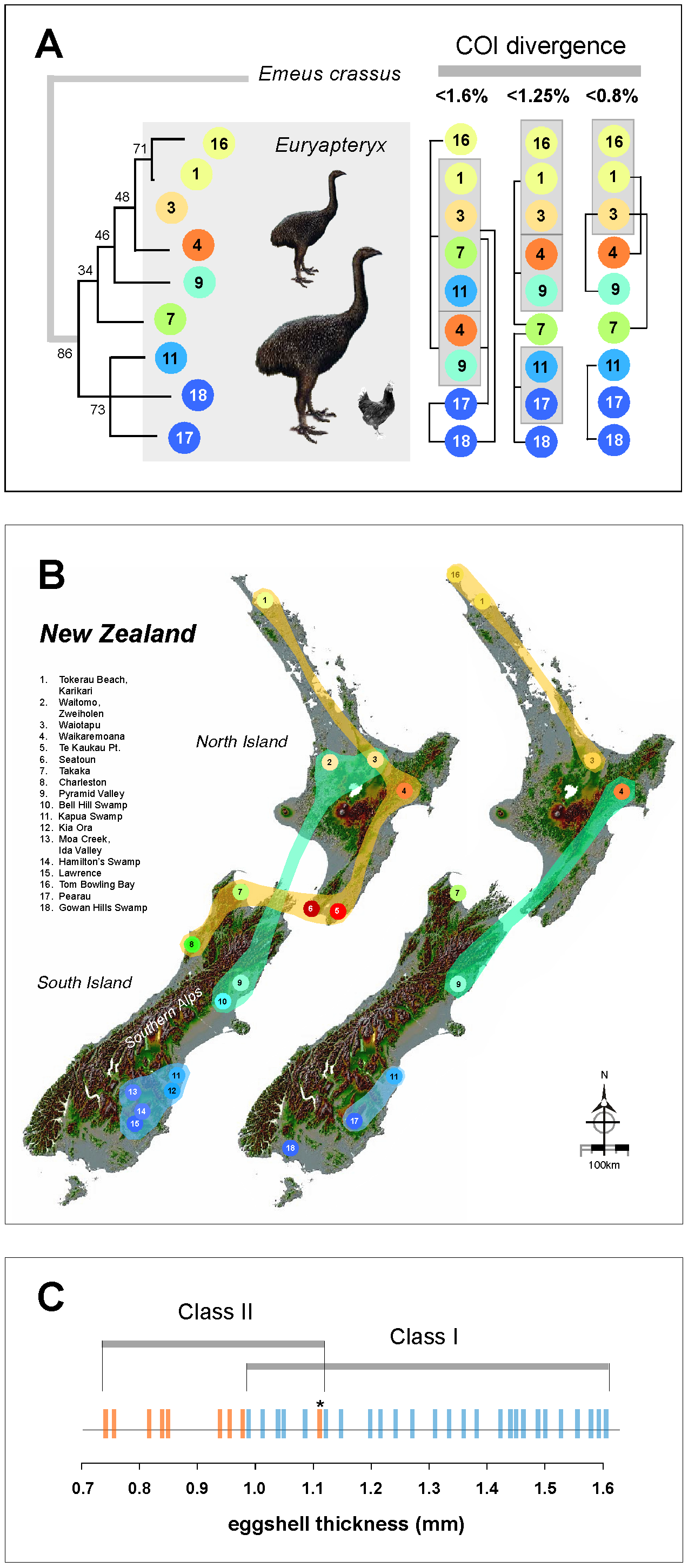Just how many species existed of the extinct New Zealand moa? The status for extinct moa (Aves: Dinornithiformes) from the genus Euryapteryx isn't as clear cut as it might seem.
Dr. Leon Huynen, lead author of a new paper said the challenges of understanding extinct fauna can be formidable and particularly so when it comes to this ancient bird. "Despite more than 100 years of research being devoted to the issue, determining species status is challenging, especially where there is an absence of substantial morphological, physiological, and behavioral data.
"Moa were comprised of a relatively large number of species that can be grouped into six genera. One of these genera, Euryapteryx, has been difficult to characterise into its constituent species, so this is the genus we have focused upon.
"Using a DNA barcoding technique we were able to show that two species were likely to have existed in the genus Euryapteryx, with the possibility of some subspecies."

COI sequence differences, biogeography, and eggshell thicknesses of Euryapteryx.
A. Phylogenetic analysis and grouping of Euryapteryx samples at various levels of COI sequence divergence. A phylogenetic tree was constructed in MEGA 5.05 [18] using Maximum Likelihood and Tamura-Nei parameters (log likelihood −1581.8; [20]). Bootstrap values were calculated from 500 replications. Sequence differences were calculated using K2 parameters. Individual Euryapteryx samples are numbered (for museum voucher numbers see supplementary information) and coloured according to location (see B). Samples are grouped according to percent COI divergence (<0.8%, <1.25%, and <1.6%). See supplementary information for divergence tables. Approximate sizes for two genetic variants (557C/T) of Euryapteryx (see text) are shown against that of an adult chicken. B. Biogeography of Euryapteryx populations according to (left) mitochondrial control region sequences from [4] or (right) COI sequences. Samples that form clades are joined by colour. The main COI groups were determined using a <1.25% divergence limit. This limit most closely approximated the clades formed using control region sequences. The complex interactions between individual members of each COI clade (see A) are not shown. Figure numbers refer to moa samples; 1 - AIM B6595ii [3], 2 - WO 527 [4], 3 - AIM B6580 [3], 4 - AIM B6228 [3], 5 - MNZ S40891 [4], 6 - MNZ S465 [4], 7 - CM Av21330 [3], 8 - CM Av29440a [4], 9 - CM Av8378 [3], 10 - MNZ S39965 [4], 11 - CM Av9188 [3], 12 - AM 6237 [4], 13 - OU Anthro FB271 [4], 14 - OM Av4735 [4], 15 - OM Av5191 [4], 16 - AIM B9243, 17 - OM Av9821 [3], 18 - CM Av38561 [3]. C. Eggshell thicknesses of Euryapteryx. Eggshell thicknesses from [10] (mm) are grouped according to association with class I (blue) or class II (orange) control region sequences [10]. These sequences cover a highly variable ~30 bp fragment that is capable of distinguishing ‘thin’ Euryapteryx eggshells from ‘thick’. *The association of a class II sequence with this 1.11 mm eggshell may be in doubt as the sequence was obtained from the outer layer of the eggshell [10].
The inability to form well-supported clades using either COI or control region sequences suggest that population structure in those individuals was in a state of flux, possibly as a result of continuing hybridization. Euryapteryx are unique in this regard, they say, being the only moa that at the molecular level at least does not show distinct South Island/North Island divergence.
Co-author Professor David Lambert said that while the study provided new insights it has not proven as enlightening as they had hoped.
"Although DNA barcoding is very successful in determining most other species of birds, including the other moa species, for some reason the results were not as clear with Euryapteryx and therefore it is not possible to precisely discriminate possible species," said Lambert. "Using this DNA barcoding technique we have been able to show that species status in Euryapteryx is very complex with there is no clear separation between various individuals and that this is possibly the result of repeated hybridisation events within the genus.
"Our results do provide a clearer picture of the species status of Euryapteryx, however, and support the suggestion that two species of Euryapteryx may have existed during the Holocene as well as a subspecies (possibly attributable to E. curtus curtus) that is found solely on New Zealand's North Island."






Comments